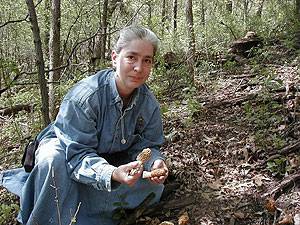|
Audio
Photos
More from MPR
Resources
Your Voice
|
May means morel mushrooms in the southeast
May 23, 2003
For outdoor enthusiasts, the month of May holds special meaning. Birds return from their winter migration and wild flowers push up through the muddy ground. And for a 2-3 week window, the morel mushroom abounds in southeastern Minnesota. The mushroom is so prized by gourmet cooks that it entices hundreds, if not thousands, of avid morel hunters into the woods.
Eitzen, Minn. — It's early May and Dave Palmquist walks slowly towards a wooded hillside. He keeps eyes glued to the ground. Then he finds it -- a tan dimpled mushroom. It's Plamquist's first morel of the season.
"When they start popping up like this one right here, people get all excited. And then they spend time walking around and finding, hopefully, lots of them," says Palmquist.
Palmquist squats down and examines the morel. He's a naturalist at Whitewater State Park. Over the years he's taught novices the fine art of morel hunting.
 | |||
Palmquist recommends scouring around dead elm trees. Recently burned areas are also known to produce a healthy crop of morels. It's time to head to the woods and search in earnest when the lilacs begin to bloom. But there are no absolutes in morel hunting.
Palmquist says fickle spring weather plays a major role.
"You need warm enough. You need wet enough. It can be too cool. It can be too dry," he explains. "If you have a lot of sunny, hot, windy, low-humidity days -- that's not good either. It has to be just right."
About a week later, on a perfect spring day, Kelly Larson bushwhacks through briar and nettles at public park in Red Wing. Larson wears a long-sleeved blouse, a billowing denim skirt, and a wide-brimmed hat. She leans heavily on her walking stick.
Larson is something of an expert when it comes to searching for morels. She says this is her favorite time of year.
 | |||
"I start dreaming about going out and collecting morels in March," says Larson. "I've actually woken up with sore muscles, because in my dreams I've been crawling uphill on my hands and knees looking for mushrooms -- imagining the perfect mushroom."
Morels are known for their nutty texture and meaty taste. Where there's one morel, there's bound to be many more.
Larson heads uphill. At the top, she stops and gasps.
"There's two, four, six," she says, quickly counting. "There's got to be a dozen mushrooms -- and they're huge. They are a good six to seven inches. We have to get a picture of them."
Larson says these are yellow morels, otherwise known as Morchella esculenta. About a foot downhill there are even more.
 | |||
Larson carefully cuts each morel away from the root, placing them in a special loose-woven basket. She says it's crucial to carry morels properly.
"The way these propagate -- they don't develop seeds, they develop spores -- and the spores fall out of these little pits. As we walk along here it's dropping spores and reseeding," says Larson. "If you keep them in a plastic bag they'll never hit the ground."
These morels will probably end up in a rich cream of mushroom soup -- Larson's favorite.
But other morels gathered by professional mushroom pickers will temporarily end up at Wiebke Fur. It's a tiny trading company in the town of Eitzen, a Minnesota community poised between the borders of Wisconsin and Iowa.
Jason Wiebke represents the third generation of his family's business. He and a group of men work assembly-line style, cleaning and trimming huge piles of mushrooms.
"We had some gentlemen come in a little while ago with 103 pounds of morels. They were down a little far south of here where it's warmer, and they said it's just loaded," says Wiebke.
Wiebke fills 10-pound boxes with the mushrooms. Each box sells for roughly $140. He says the overwhelming majority of his stock is destined for Indiana -- in particular, this weekend's Indianapolis 500 car race, where it's become a tradition to munch on morels as the cars whiz by.
|
News Headlines
|
Related Subjects
|

